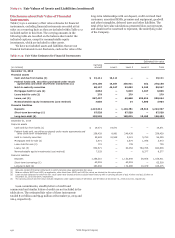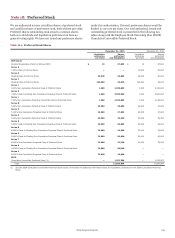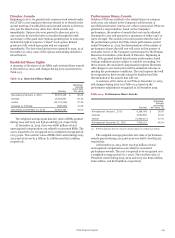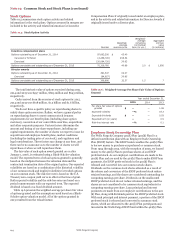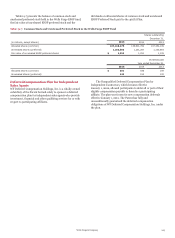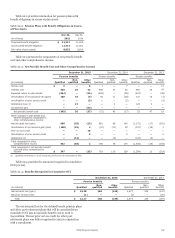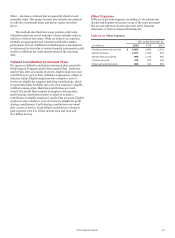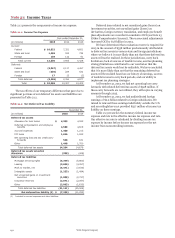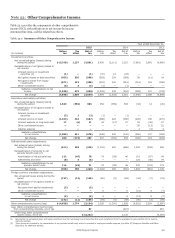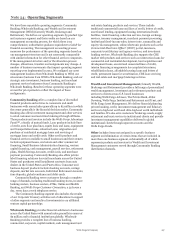Wells Fargo 2015 Annual Report Download - page 250
Download and view the complete annual report
Please find page 250 of the 2015 Wells Fargo annual report below. You can navigate through the pages in the report by either clicking on the pages listed below, or by using the keyword search tool below to find specific information within the annual report.
Note 20: Employee Benefits and Other Expenses (continued)
Plan Assumptions Policies). Table 20.5 presents the weighted-average discount
For additional information on our pension accounting rates used to estimate the projected benefit obligation for
assumptions, see Note 1 (Summary of Significant Accounting pension benefits.
Table 20.5: Discount Rates Used to Estimate Projected Benefit Obligation
December 31, 2015
Pension benefits
December 31, 2014
Pension benefits
Discount rate
Qualified
4.25%
Non-
qualified
4.25
Other
benefits
4.25
Qualified
4.00
Non-
qualified
3.75
Other
benefits
4.00
Table 20.6 presents the weighted-average assumptions used
to determine the net periodic benefit cost.
Table 20.6: Weighted-Average Assumptions Used to Determine Net Periodic Benefit Cost
December 31, 2015 December 31, 2014 December 31, 2013
Pension benefits Pension benefits Pension benefits
Non- Other Non- Other Non- Other
Qualified qualified benefits Qualified qualified benefits Qualified qualified benefits
Discount rate (1) 4.00% 3.60 4.00 4.75 4.16 4.50 4.38 4.08 3.75
Expected return on plan assets 7.00 N/A 6.00 7.00 N/A 6.00 7.50 N/A 6.00
(1) The discount rate for the 2013 qualified pension benefits and for the 2015, 2014, and 2013 nonqualified pension benefits includes the impact of quarter-end
remeasurements when settlement losses are recognized.
To account for postretirement health care plans we use
health care cost trend rates to recognize the effect of expected
changes in future health care costs due to medical inflation,
utilization changes, new technology, regulatory requirements
and Medicare cost shifting. In determining the end of year
benefit obligation we assume an average annual increase of
approximately 9.30%, for health care costs in 2016. This rate is
assumed to trend down 0.40%-0.60% per year until the trend
rate reaches an ultimate rate of 5.00% in 2024. The 2015
periodic benefit cost was determined using an initial annual
trend rate of 7.00%. This rate was assumed to decrease 0.25%
per year until the trend rate reached an ultimate rate of 5.00% in
2023. Increasing the assumed health care trend by one
percentage point in each year would increase the benefit
obligation as of December 31, 2015, by $34 million and the total
of the interest cost and service cost components of the net
periodic benefit cost for 2015 by $2 million. Decreasing the
assumed health care trend by one percentage point in each year
would decrease the benefit obligation as of December 31, 2015,
by $30 million and the total of the interest cost and service cost
components of the net periodic benefit cost for 2015 by
$2 million.
Investment Strategy and Asset Allocation
We seek to achieve the expected long-term rate of return with a
prudent level of risk given the benefit obligations of the pension
plans and their funded status. Our overall investment strategy is
designed to provide our Cash Balance Plan with long-term
growth opportunities while ensuring that risk is mitigated
through diversification across numerous asset classes and
various investment strategies. We target the asset allocation for
our Cash Balance Plan at a target mix range of 30%-50%
equities, 40%-60% fixed income, and approximately 10% in real
estate, venture capital, private equity and other investments. The
Employee Benefit Review Committee (EBRC), which includes
several members of senior management, formally reviews the
investment risk and performance of our Cash Balance Plan on a
quarterly basis. Annual Plan liability analysis and periodic asset/
liability evaluations are also conducted.
Other benefit plan assets include (1) assets held in a 401(h)
trust, which are invested with a target mix of 40%-60% for both
equities and fixed income, and (2) assets held in the Retiree
Medical Plan Voluntary Employees' Beneficiary Association
(VEBA) trust, which are invested with a general target asset mix
of 20%-40% equities and 60%-80% fixed income. In addition,
the strategy for the VEBA trust assets considers the effect of
income taxes by utilizing a combination of variable annuity and
low turnover investment strategies. Members of the EBRC
formally review the investment risk and performance of these
assets on a quarterly basis.
Projected Benefit Payments
Future benefits that we expect to pay under the pension and
other benefit plans are presented in Table 20.7. Other benefits
payments are expected to be reduced by prescription drug
subsidies from the federal government provided by the Medicare
Prescription Drug, Improvement and Modernization Act of
2003.
Table 20.7: Projected Benefit Payments
Pension benefits Other benefits
(in millions) Qualified
Non-
qualified
Future
benefits
Subsidy
receipts
Year ended
December 31,
2016 $ 762 61 86 11
2017 753 60 87 12
2018 737 56 87 12
2019 740 53 87 12
2020 745 52 87 12
2021-2025 3,578 224 410 61
Wells Fargo & Company
248


